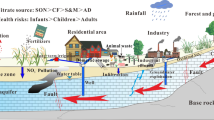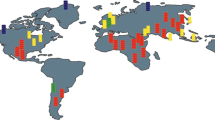Abstract
A comprehensive set of measurements of oxygen and hydrogen isotopic ratios in groundwaters as well as waters from rivers, lakes, hot springs etc. taken from a variety of locations in India has been carried out for the first time. Isotopically the most depleted samples occur in the high altitude precipitations in the Himalayas e.g. in the lakes of Bhutan and the source water of the Ganga. The shallow groundwater data display a continental effect where the heavy isotope content decreases with distance from the coast (about 4 to 6 per mil decrease in δ18O per 1000 km). The δ D and δ18O of these fresh waters are linearly related and an analysis of this relation vis-a-vis the meteoric water line shows the unambiguous effect of enrichment due to evaporation from soils.
Similar content being viewed by others
References
Bigeleisen J, Perlman M L and Prosser H C 1952Anal. Chem. 24 1356
Burgman J O S, Eriksson E, Rostov L and Moller A 1979Isotope hydrology 1978 (Proc. Int. Symp. Neuherberg) (Vienna:IAEA) Vol. 1, p. 40
Craig H 1961Science 133 1702
Dansgaard W 1964Tellus 16 436
Duplessy J C, Be A W H and Blanc P L 1981Palaeogeogr. Palaeoclimatol, Palaeoecol. 33 9
Epstein S and Mayeda T 1953Geochim. Cosmochim. Acta 4 213
Friedman I and Hardcastle K 1970Geochim. Cosmochim. Acta 34 125
Fritz P 1981Stable isotope hydrology: deuterium and oxygen-18in the water cycle (eds) J R Gat and R Gonfiantini (Vienna:IAEA) p. 177
Gat J R 1981Stable isotope hydrology: deuterium and oxygen-18in the water cycle (eds) J R Gat and R Gonfiantini (Vienna:IAEA) p. 203
Gat J R 1983Palaeoclimates and palaeowaters: a colledion of environmental isotope studies (Vienna:IAEA) p. 3
Krishnamurthy R V 1984Stable isotope studies on sedimentary deposits and groundwaters and their climatic implications Ph.D. thesis, Gujarat University p. 52
Rao Y P 1976 South-West Monsoon,Meteorol. Monograph, No. 1, India Meteorol. Dept., p. 1
Rozanski K, Sonntag C and Munnich K O 1982Tellus 34 142
Siegenthaler V and Oeschger H 1980Nature 285 314
Sonntag C, Klitzsch E, Lohnen E P, El-Shazley E M, Munnich K O, Junghans Ch, Thorweihe U, Weistroffer K and Swailem F M 1979Isotope hydrology 1978 (Proc. Int. Symp. Neuherberg) (Vienna:IAEA) Vol. 2, p. 580
Vogel J and Van Urk H 1975J. Hydrol. 25 23
Weyer K U, Krouse H R and Horwood W C 1979Isotope hydrology 1978 (Proc. Int. Symp. Neuherberg) (Vienna:IAEA) Vol. 1, p. 263
Yurtsever Y and Gat J R 1981Stable isotope hydrology: deuterium and oxygen-18 in the water cycle (eds) J R Gat and R Gonfiantini (Vienna: IAEA) p. 103
Zimmerman U, Ehhalt D and Munnich K O 1967Isotopes in Hydrology (Proc. Symp. Vienna) p. 567
Author information
Authors and Affiliations
Rights and permissions
About this article
Cite this article
Bhattacharya, S.K., Gupta, S.K. & Krishnamurthy, R.V. Oxygen and hydrogen isotopic ratios in groundwaters and river waters from India. Proc. Indian Acad. Sci. (Earth Planet Sci.) 94, 283–295 (1985). https://doi.org/10.1007/BF02839206
Received:
Revised:
Issue Date:
DOI: https://doi.org/10.1007/BF02839206




